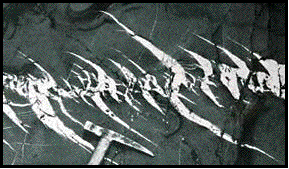An Introduction to Structural Geology and Tectonics
An Introduction to Structural Geology and Tectonics |
7. Joints and Veins
 Visitors
from around the world trek to Arches National Park in southeastern Utah
(USA) to marvel at its graceful natural arches. These arches appear to
have been carved through high, but relatively thin, free-standing sandstone
walls. From the air, you can see that the park contains a multitude of
such walls, making its landscape resemble a sliced-up loaf of bread. The
surfaces of rock walls in Arches Park initiated as joints, which are natural
fractures in rock across which there has been no shear displacement. Erosive
processes through the ages have preferentially attacked the walls of the
joints, so that today you can walk in the space between the walls. Though
joints are not always as dramatic as those in Arches National Park, nearly
all outcrops contain joints. At first glance, joints may seem to be simple
and featureless geologic structures, but in fact they are well worth studying,
not only because of their importance in controlling landscape morphology,
but also because they profoundly affect rock strength and permeability,
and because they can provide a detailed, though subtle history of stress
and strain in a region. Although the basic definition of the term joint
is non-genetic, most contemporary geologists who study joints believe that
they form during Mode I loading (see Chapter
6), i.e., they are tensile fractures that form perpendicular to the
sigma3 trajectory and parallel to the principal plane of stress that contains
the sigma1 and sigma2 directions at the time they formed. Not all geologists
share this viewpoint, and some researchers use the term 'joint' when referring
to shear fractures as well. This second usage is ambiguous, because structures
that are technically faults might also be referred to as joints and, therefore,
we do not use the term 'joint' in reference to a shear fracture. In this
chapter, we begin by describing the morphology of individual joints and
the geometric characteristics of groups of joints. Then, we discuss how
to study joints in the field, and how to interpret them. We conclude by
describing veins, which are fractures filled with minerals that precipitated
from a fluid. But before we begin, we offer a note of caution. The interpretation
of joints and veins remains quite controversial, and it is common for field
trips that focus on these structures to end in heated debate. As you read
this chapter, you'll discover why.
Visitors
from around the world trek to Arches National Park in southeastern Utah
(USA) to marvel at its graceful natural arches. These arches appear to
have been carved through high, but relatively thin, free-standing sandstone
walls. From the air, you can see that the park contains a multitude of
such walls, making its landscape resemble a sliced-up loaf of bread. The
surfaces of rock walls in Arches Park initiated as joints, which are natural
fractures in rock across which there has been no shear displacement. Erosive
processes through the ages have preferentially attacked the walls of the
joints, so that today you can walk in the space between the walls. Though
joints are not always as dramatic as those in Arches National Park, nearly
all outcrops contain joints. At first glance, joints may seem to be simple
and featureless geologic structures, but in fact they are well worth studying,
not only because of their importance in controlling landscape morphology,
but also because they profoundly affect rock strength and permeability,
and because they can provide a detailed, though subtle history of stress
and strain in a region. Although the basic definition of the term joint
is non-genetic, most contemporary geologists who study joints believe that
they form during Mode I loading (see Chapter
6), i.e., they are tensile fractures that form perpendicular to the
sigma3 trajectory and parallel to the principal plane of stress that contains
the sigma1 and sigma2 directions at the time they formed. Not all geologists
share this viewpoint, and some researchers use the term 'joint' when referring
to shear fractures as well. This second usage is ambiguous, because structures
that are technically faults might also be referred to as joints and, therefore,
we do not use the term 'joint' in reference to a shear fracture. In this
chapter, we begin by describing the morphology of individual joints and
the geometric characteristics of groups of joints. Then, we discuss how
to study joints in the field, and how to interpret them. We conclude by
describing veins, which are fractures filled with minerals that precipitated
from a fluid. But before we begin, we offer a note of caution. The interpretation
of joints and veins remains quite controversial, and it is common for field
trips that focus on these structures to end in heated debate. As you read
this chapter, you'll discover why.